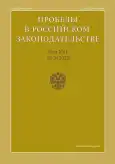Cyberterrorism Among the Youth: the Main Causes and Methods of Counteraction
- Authors: Chochaev T.H.1
-
Affiliations:
- Krasnodar University of the Ministry of Internal Affairs of Russia
- Issue: Vol 16, No 5 (2023)
- Pages: 201-205
- Section: General theoretical, criminal-legal and other problems of Countering extremism and terrorism. Problems of preventing extremism and terrorism
- URL: https://journals.eco-vector.com/2072-3164/article/view/568822
- EDN: https://elibrary.ru/LZLLGJ
- ID: 568822
Cite item
Abstract
The purpose of this study is to involve young people in destructive ideologies and illegal activities. Regardless of age, people have access to modern technology that can access the Internet and perform certain tasks. The youth audience has an increased risk group, as they can easily be recruited, for example, by terrorists. Terrorists spread disinformation, intimidate the population, create panic, try to create an atmosphere of helplessness. Terrorism has a political character, but it can operate not only in the political, but also in the social, psychological, and economic spheres. Cyberspace helps to perform such tasks quickly, with minimal risk of being caught. Terrorists keep in touch with each other, communicate, recruit new members, manage groups, and distribute extremist materials also using the Internet. Most spheres of life, including the economy, are gradually globalizing and going digital, this makes them more convenient and accessible, allows you to speed up many processes and make them accessible from anywhere in the world. However, such automation brings not only progress, but also a threat from cyberterrorists. The purpose of cyberterrorism is to destabilize the political situation, put pressure on the authorities, force them to make certain decisions that are beneficial to terrorists, as well as the threat of violence in order to influence decision-making by public authorities.
It has been established that the attention of terrorists in recent years has been attracted by social networks that allow them to enter into direct contact with individuals or groups, conduct a dialogue, and defend their position. Networks help them to keep in touch with their colleagues, to prepare attacks. The preparation, coordination and conduct of terrorist acts can also be carried out via the Internet with the help of special programs.
Full Text
About the authors
Tamerlan H. Chochaev
Krasnodar University of the Ministry of Internal Affairs of Russia
Author for correspondence.
Email: sayfullah10021996@mail.ru
Police Senior Lieutenant, Lecturer of the Department of Fire Training, North Caucasus Institute for Advanced Studies (branch)
Russian Federation, Nalchik, KBRReferences
- Abazov I.S. On ways to counter cyberterrorist threats // Journal of Applied Research. 2022. Vol. 2. No. 6. pp. 178-181.
- Amirova D.K., Gabdrakhmanova R.I. Cyberterrorism as a modern threat to the security of citizens // Scientific Notes of the Kazan Law Institute of the Ministry of Internal Affairs of Russia. 2021. Vol. 6. No. 2 (12). pp. 126-131.
- Gedgafov M.M. Measures to counter cyberterrorist threats in the context of globalization of the information space // Gaps in Russian legislation. 2021. Vol. 14. No. 4. pp. 112-115.
- Zhukov A.Z. Improvement of tools for countering cyberterrorism in modern conditions // Gaps in Russian legislation. 2021. Vol. 14. No. 5. pp. 123-128.
- Kobets P.N. Cyberterrorism as the most important threat to national security // National security and strategic planning. 2022. No. 1 (37). pp. 23-28.
- Malaev A.H. ON the actual problems of countering cyberterrorist threats in the context of digital transformation // Gaps in Russian legislation. 2022. Vol. 15. No. 4. pp. 214-218.
- Teuvazhukov A.H., Khitieva A.J. Commission of cyberterrorist crimes on the Internet: ways of detection and counteraction // Journal of Applied Research. 2022. Vol. 1. No. 9. pp. 72-75.
- Khamurzov A.T. Cyberterrorism: new challenges and counteraction measures // Journal of Applied Research. 2021. No. 3-2. pp. 74-77.
- Khachidogov R.A. Cyberterrorism in the global information space: new challenges and counteraction measures // Education and Law. 2021. No. 6. pp. 362-366.
- Tsrimov A.A. Features of the use of digital technologies in countering cyberterrorism // Gaps in Russian legislation. 2022. Vol. 15. No. 4. pp. 145-148.
- Stoll V.V., Zadokhin A.G. Information and communication technologies and information security of Russia // Obozrevatel. 2022. No. 5-6 (388-389). pp. 66-78.
Supplementary files








